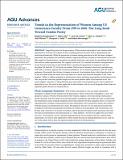| dc.contributor.author | Ranganathan, Meghana | |
| dc.contributor.author | Lalk, Ellen | |
| dc.contributor.author | Freese, Lyssa M. | |
| dc.contributor.author | Freilich, Mara Amelia | |
| dc.contributor.author | Wilcots, Julia | |
| dc.contributor.author | Duffy, Margaret L. | |
| dc.contributor.author | Shivamoggi, Rohini | |
| dc.date.accessioned | 2021-10-08T19:44:46Z | |
| dc.date.available | 2021-10-08T19:44:46Z | |
| dc.date.issued | 2021-08 | |
| dc.date.submitted | 2021-03 | |
| dc.identifier.issn | 2576-604X | |
| dc.identifier.uri | https://hdl.handle.net/1721.1/132920 | |
| dc.description.abstract | Inequalities persist in the geosciences. White women and people of color remain under-represented at all levels of academic faculty, including positions of power such as departmental and institutional leadership. While the proportion of women among geoscience faculty has been cataloged previously, new programs and initiatives aimed at improving diversity, focused on institutional factors that affect equity in the geosciences, necessitate an updated study and a new metric for quantifying the biases that result in under-representation. We compile a data set of 2,531 tenured and tenure-track geoscience faculty from 62 universities in the United States to evaluate the proportion of women by rank and discipline. We find that 27% of faculty are women. The fraction of women in the faculty pool decreases with rank, as women comprise 46% of assistant professors, 34% of associate professors, and 19% of full professors. We quantify the attrition of women in terms of a fractionation factor, which describes the rate of loss of women along the tenure track and allows us to move away from the metaphor of the “leaky pipeline.” Efforts to address inequities in institutional culture and biases in promotion and hiring practices over the past few years may provide insight into the recent positive shifts in fractionation factor. Our results suggest a need for 1:1 hiring between men and women to reach gender parity. Due to significant disparities in race, this work is most applicable to white women, and our use of the gender binary does not represent gender diversity in the geosciences. | en_US |
| dc.publisher | American Geophysical Union (AGU) | en_US |
| dc.relation.isversionof | http://dx.doi.org/10.1029/2021av000436 | en_US |
| dc.rights | Creative Commons Attribution NonCommercial License 4.0 | en_US |
| dc.rights.uri | https://creativecommons.org/licenses/by-nc/4.0/ | en_US |
| dc.source | American Geophysical Union (AGU) | en_US |
| dc.title | Trends in the Representation of Women Among US Geoscience Faculty From 1999 to 2020: The Long Road Toward Gender Parity | en_US |
| dc.type | Article | en_US |
| dc.identifier.citation | Ranganathan, Meghana et al. "Trends in the Representation of Women Among US Geoscience Faculty From 1999 to 2020: The Long Road Toward Gender Parity." AGU Advances 2, 3 (August 2021): e2021AV000436. © 2021 American Geophysical Union | en_US |
| dc.contributor.department | Massachusetts Institute of Technology. Department of Earth, Atmospheric, and Planetary Sciences | en_US |
| dc.contributor.department | Woods Hole Oceanographic Institution | en_US |
| dc.relation.journal | AGU Advances | en_US |
| dc.eprint.version | Final published version | en_US |
| dc.type.uri | http://purl.org/eprint/type/JournalArticle | en_US |
| eprint.status | http://purl.org/eprint/status/PeerReviewed | en_US |
| dspace.date.submission | 2021-09-20T15:36:54Z | |
| mit.journal.volume | 2 | en_US |
| mit.journal.issue | 3 | en_US |
| mit.license | PUBLISHER_CC | |
| mit.metadata.status | Complete | en_US |
